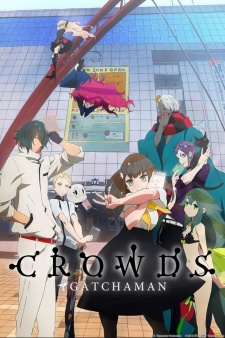
Gatchaman Crowds lies at the intersection of superheroes and the interconnected world of technology. The superheroes, Gatchamen, fight against a vaguely defined alien presence that only seems to be on screen for the first few episodes before disappearing into obscurity. On a completely different thread, an online game used for incentivizing social good gets hijacked by a crazed shapeshifter, who throws the world into chaos by manifesting online avatars into amorphous blue blobs with TV heads. And maybe it is fallacious to say that the show lies at their intersection, because their intersection seems ill-defined at best. It feels more like a group of superheroes who went looking for alien invaders and accidentally stumbled into the wrong anime.
Actually, there are a lot of themes that seem out of place in Gatchaman Crowds. The Gatchamen listen to prophesies from a creepy old man who cuts bird shapes out of origami paper, before going out to fight floating Rubik’s cubes to restore peace to the city. They are led by a tiny panda from another planet, but their personalities are also colorful enough to be otherworldly themselves, from an impossibly happy and energetic girl with outdated speech patterns to a pint-sized girl in underwear only capable of saying “I’m depressed”, to an okama character with yellow lipstick.
In fact I count three crossdressers in the show: one Gatchaman, the sinister villain, and the programming creator of the net game GALAX. The first, O.D., is upbeat and slightly mischevious; the second, Katze, is downright sadistic and crazy, and the third, Rui, is…terrifyingly average for his off-the-walls counterparts. Yet it is his creation GALAX that takes over the show, even in the early stages that were ostensibly focused more on the Gatchamen. His game crowdsources social good, using both people’s desire to do good and a bizarre power to manifest superhuman help, granted to him by the shapeshifting Katze. Why anyone could trust Katze, with the maniacal laugh and literal demon tail, is beyond me; they soon betray Rui and take over the game, taking back the power they granted Rui and using the crowds on the game as fuel for mass destruction and social revolution. What to do? Call in the Gatchamen! They weren’t busy doing anything else anyway.
While the characters’ eccentricities may seem a bit too single-minded at times, the visuals do bring quite a bit to the table as both eclectic and fitting. The entire aesthetic is reminiscent of Katanagatari , with hair having a background pattern and everything done with a bright pastel color palate, but while the setting of the world is fairly ordinary, there is a pervasive sense of futurism and technology outpacing reality. Both the Gatchamen’s suits and the alien cubes are detailed and constantly shifting, which combine with the technological overlay of GALAX and an electronic soundtrack to create a nicely rendered futuristic image. Then we dip into the Gatchamen’s lair itself and see a children’s toyroom, cluttered and disorderly, as well as a meeting hall much like the Senate chamber from the Star Wars prequels. The imagery, while crowded, is memorable.
Still crowded it is, and if there were a word to describe Gatchaman Crowds , it would be “claustrophobic”. Maybe by the end of the next season we will know how it all fits into a more coherent narrative, merging different messages about the characters, the life of a Gatchaman, and the place of technology in a society trying to upgrade and connect. Another question worth answering is how Gatchaman Crowds , as a reimagination of the classic 1970’s Gatchaman franchise that so successfully emulated the Western superhero genre, fits into the framework of its predecessor. The dangers of new technology is certainly similar to before, albeit upgraded from environmentalism to interconnectivity, and the signature call of “bird, go!” signals the Gatchaman transformation sequence once again. However, no continuity seems to be ascribed to the two shows, barring a few similar names, so it will be nice to see how things are tied together.